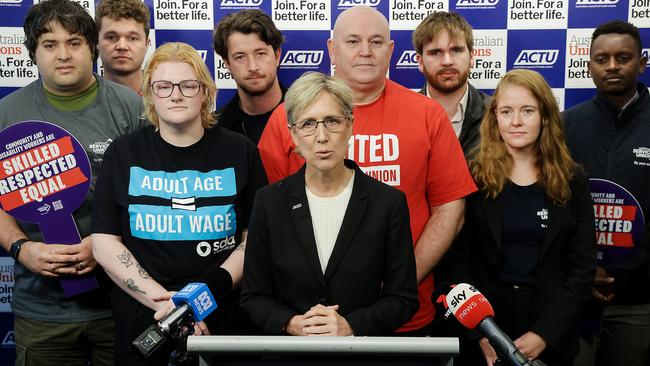Win on pay for 3 million workers but productivity goes begging
The Fair Work Commission has awarded an above-inflation 3.5 per cent pay rise to more than 3m workers, sparking business calls for Labor to urgently address flatlining productivity growth.

The Fair Work Commission has awarded an above-inflation 3.5 per cent pay rise to more than three million workers, and opened the way for a new round of gender-based wage increases for professionals, sparking business calls for Labor to urgently address flatlining productivity growth.
Awarding the biggest real wage increase to the nation’s lowest paid in years, Fair Work president Adam Hatcher said the $32-a-week rise was needed to prevent the recent fall in the living standards of award-reliant workers becoming entrenched.
Splitting the difference between union and employer claims, the decision backs the federal government’s calls for an above-inflation rise, and will flow to an estimated 2.6 million award-reliant workers as well as 500,000 employees covered by enterprise agreements that tie pay rises to the annual wage decision, including 200,000 workers at Coles and Woolworths.
Building on its recent recommendation for wage increases of up to 35 per cent for 175,000 low-paid workers in female-dominated sectors, the commission set in train a second round of gender-based pay rises for award-reliant professionals.
As the restaurant sector claimed the higher labour costs from July 1 would lead to higher menu prices for customers, Anthony Albanese said the decision would not drive up prices but would ensure that workers “don’t fall behind when it comes to cost of living”.
Declaring workers had “turned the corner” on wages, ACTU secretary Sally McManus welcomed the 3.5 per cent increase, noting it represented a 1.1 per cent increase in real wages, given the 2.4 per cent inflation rate. Ms McManus endorsed the commission’s decision to examine gender undervaluation among professionals covered by 21 awards, including school staff, law and architecture graduates, trainee book editors, ambulance officers, live performance production workers and veterinary surgeons.
“This is another crucial step on the road to securing equal pay for all working Australians, but we are not there yet,” she told The Australian. Employer groups said the “generous” increase in award wages highlighted the need for the government to address flatlining productivity growth.
Australian Industry Group chief executive Innes Willox said real wages growth was only sustainable when supported by proportionate productivity uplifts, and investment was likely to suffer as employers needed to find the money to fund the above-inflation pay rises.
“By giving insufficient attention to the well-established link between real wages and productivity, this decision will further suppress private sector investment and employment generation at a time our economy can least afford it,” Mr Willox said.
As Workplace Relations Minister Amanda Rishworth met employers and unions in Melbourne to discuss Labor’s policy agenda and productivity, including the role of artificial intelligence in the workplace, Australian Chamber of Commerce and Industry chief executive Andrew McKellar said “there are huge opportunities there for business and government and unions to work together to try and get some quick wins on the board in terms of productivity”.
“In the long term, that’s the only way we’re going to be able to have sustainable increases in real wages without running the risk of restarting inflation,” he said.
Increasing the hourly minimum wage rate from $24.10 to $24.95, and the weekly amount from $915.90 to $948, Justice Hatcher said Australia’s continuing poor performance in labour productivity growth had operated as a restraining factor on the size of the increase.
“That problem is primarily located in the non-market sector, where there has been significant growth in employment in the healthcare and social services sectors in recent years,” he said. “In the market sector, there has been modest growth in labour productivity over the current multi-year cycle, which indicates some capacity for business to pay for a modest increase in real minimum wages. Certainly, the productivity problem will not be resolved by the indefinite continuation of the reduction in real wages which has occurred over the last four years.”
Justice Hatcher said the tribunal’s principal consideration was that the inflation spike in 2021-22 had seen a reduction in the real value of award wages, with the benchmark rate falling by 4.5 per cent relative to inflation.
“We are concerned that if this opportunity is not taken in this annual wage review, the loss in the real value of wages which has occurred will become permanently embedded in the modern award system and the national minimum wage, and a reduction in living standards for the lowest paid in the community will thereby be entrenched,” he said.
Ms Rishworth said the government was committed to addressing the productivity challenge but it was “much broader than the minimum wage and workplace relations”.
“Paying our minimum workers less does not help with productivity growth. That is not the way to get labour productivity growth in this country,” she said.
“It’s clear the commission considered this. We are up for tackling the productivity challenges that our country has. But paying people less, and particularly those on the minimum wage, to be quite frank, is not the answer.”
Justice Hatcher said the commission, in its last three annual wage review decisions, had repeatedly deferred taking any action to reverse this decline in real wages out of a concern that this might result in the persistence of higher inflation.
“The result has been that living standards for employees dependent on modern award wages have been squeezed and the low paid have experienced greater difficulty in meeting their everyday needs,” he said.
He said the Reserve Bank’s assessment that inflation had sustainably returned to its target range of 2 to 3 per cent indicated that this inflationary episode was now over. “That provides us with an opportunity to go at least some of the way towards correcting what has happened over the last four years by awarding a real increase to modern award wages and the national minimum wage,” he said. He said the commission was satisfied that the 3.5 per cent increase was sustainable.
“The labour market remains strong overall, with continuing employment growth, low unemployment and historically high rates of participation in the workforce,” he said.
“Reductions in interest rates are likely to lead to higher consumer demand and a higher level of economic growth than we have experienced in recent times. Although business has faced challenging circumstances in recent times, business conditions have remained reasonably healthy, with the level of non-mining profits maintained in real terms and profit margins at approximately their pre-pandemic level.”







To join the conversation, please log in. Don't have an account? Register
Join the conversation, you are commenting as Logout